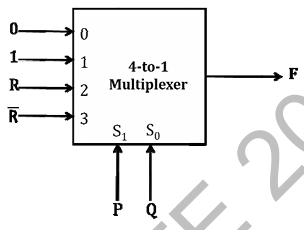CS/IT Gate Yearwise
CS/IT Gate 2025 (Set 2)
CS/IT Gate 2024 (Set 1)
CS/IT Gate 2024 (Set 2)
CS/IT Gate 2023
CS/IT Gate 2022
CS/IT Gate 2021 (Set 1)
CS/IT Gate 2021 (Set 2)
CS/IT Gate 2020
CS/IT Gate 2019
CS/IT Gate 2018
CS/IT Gate 2017 (Set 1)
CS/IT Gate 2017 (Set 2)
CS/IT Gate 2016 (Set 1)
CS/IT Gate 2016 (Set 2)
CS/IT Gate 2015 (Set 1)
CS/IT Gate 2015 (Set 2)
CS/IT Gate 2015 (Set 3)
CS/IT Gate 2014 (Set 1)
CS/IT Gate 2014 (Set 2)
CS/IT Gate 2014 (Set 3)
CS and IT GATE 2014 Set-1 Questions with Answer
Ques 27 Data Structures and Algorithms
Consider the following pseudocode. What is the total number of multiplications to be performed?
D = 2
for i = 1 to n do
for j = i to n do
for k = j + 1 to n do
D = D * 3
Ques 28 Databases
Consider the relation scheme
R = (E, F, G, H, I, J, K, L, M, N)
and the set of functional dependencies {{E, F} → {G}, {F} → {I, J}, {E, H} → {K, L}, {K} → {M}, {L} → {N}}. Which of the following is a key for R?
Ques 29 Databases
Given the following statements:
S1: A foreign key declaration can always be replaced by an equivalent check assertion in SQL.
S2: Given the table R(a, b, c) where a and b together form the primary key, the following is a valid table definition.
CREATE TABLE S(
d INT,
e INT,
PRIMARY KEY (d),
FOREIGN KEY (a) REFERENCES R
)
Which one of the following statements is CORRECT?
Ques 30 Databases
Consider the following four schedules due to three transactions (indicated by the subscript) using read and write on a data item x, denoted by r(x) and w(x) respectively. Which one of them is conflict serializable?
(A) r1(x); r2(x); w1(x); r3(x); w2(x)
(B) r2(x); r1(x); w2(x); r3(x); w1(x)
(C) r3(x); r2(x); r1(x); w2(x); w1(x)
(D) r2(x); w2(x); r3(x); r1(x); w1(x)
Ques 31 Databases
Given the following two statements:
S1: Every table with two single-valued attributes is in 1NF, 2NF, 3NF and BCNF.
S2: AB → C, D → E, E → C is a minimal cover for the set of functional dependencies AB → C, D → E, AB → E, E → C.
Which one of the following is CORRECT?
Ques 32 Databases
Given the following schema:
employees(emp-id, first-name, last-name, hire-date, dept-id, salary)
departments(dept-id, dept-name, manager-id, location-id)
You want to display the last names and hire dates of all latest hires in their respective departments in the location ID 1700. You issue the following query:
SQL> SELECT last-name, hire-date
FROM employees
WHERE (dept-id, hire-date) IN (SELECT dept-id, MAX(hire-date) FROM employees JOIN departments USING(dept-id) WHERE location-id = 1700 GROUP BY dept-id);
What is the outcome?
Ques 33 Design Algorithm Analysis
Let P be a QuickSort Program to sort numbers in ascending order using the first element as pivot. Let t1 and t2 be the number of comparisons made by P for the inputs [1, 2, 3, 4, 5] and [4, 1, 5, 3, 2] respectively. Which one of the following holds?
Ques 34 Digital Logic
Consider the 4-to-1 multiplexer with two select lines S1 and S0 given below.

Ques 35 Digital Logic
Which one of the following propositional logic formulas is TRUE when exactly two of p, q, and r are TRUE?
Ques 36 Digital Logic Design
Consider the following Boolean expression for F:
F(P, Q, R, S) = PQ + P'QR + P'QR'S
The minimal sum-of-products form of F is__________
Ques 37 Discrete Mathematics
Consider the statement
“Not all that glitters is gold”
Predicate glitters(x) is true if x glitters and predicate gold(x) is true if x is gold. Which one of the following logical formulae represents the above statement?
Ques 38 Discrete Mathematics
A pennant is a sequence of numbers, each number being 1 or 2. An n-pennant is a sequence of numbers with sum equal to n. For example, (1, 1, 2) is a 4-pennant. The set of all possible 1-pennants is {(1)}, the set of all possible 2-pennants is {(2), (1, 1)} and the set of all 3-pennants is {(2, 1), (1, 1, 1), (1, 2)}. Note that the pennant (1, 2) is not the same as the pennant (2, 1). The number of 10-pennants is _______.
Ques 39 Discrete Mathematics
Let S denote the set of all functions f: {0, 1}4 → {0, 1}. Denote by N the number of functions from S to the set {0, 1}. The value of log2log2N is _______.

Total Unique Visitors